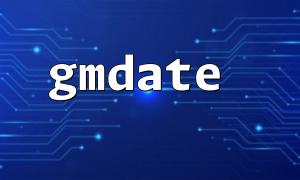In PHP, processing time and date are common requirements, while the gmdate function is used to obtain formatted time output of Greenwich Standard Time (GMT). Compared with the date function, gmdate is not affected by the server time zone settings and returns the standard UTC time. However, Daylight Saving Time (DST) often causes troubles to time processing, especially when local time conversion is involved.
This article will explain in detail how to deal with daylight saving time problems when using gmdate , and provide some practical DST processing techniques to help you manage your time more accurately in PHP projects.
gmdate returns UTC time, which itself will not be affected by daylight saving time . Daylight saving time mainly affects the time zone offset of local time, so you will encounter DST-related problems when you need to display the user's local time or convert UTC time to local time.
To give a simple example:
echo gmdate('Y-m-d H:i:s');
// The output is similar:2025-05-23 06:30:00 (UTCtime)
If your server time zone is set to a time zone with daylight saving time, the result of using the date() function will be automatically adjusted by daylight saving time.
Timestamp conversion error <br> When formatting timestamps using date() , if you do not pay attention to daylight saving time, it may lead to an early or delay of 1 hour.
Confused data processing across time zones <br> For example, if the user submits local time, the background uses UTC storage, and the daylight saving time is not processed properly, resulting in time deviation.
Timed tasks are inconsistent <br> Timed tasks that rely on the system time zone may have an exception in execution time when daylight saving time begins or ends.
The DateTime class combines time zone objects to correctly identify daylight saving time rules and avoid manually handling complex logic.
Sample code:
$date = new DateTime('now', new DateTimeZone('America/New_York'));
echo $date->format('Y-m-d H:i:s'); // Daylight saving time will be considered automatically
If you get UTC time (time generated through gmdate ), you want to convert it to local time with daylight saving time:
$utc = new DateTime('2025-05-23 10:00:00', new DateTimeZone('UTC'));
$local = $utc->setTimezone(new DateTimeZone('America/New_York'));
echo $local->format('Y-m-d H:i:s');
Assuming that you only have the UTC time and user time zone offset of gmdate (including daylight saving time adjustment), you can adjust the time by calculating the number of offset seconds:
$timestamp = time();
$utcTime = gmdate('Y-m-d H:i:s', $timestamp);
// Assume that the user time zone offset is-4Hour(Daylight saving time),Convert to seconds
$offsetSeconds = -4 * 3600;
$localTimestamp = $timestamp + $offsetSeconds;
$localTime = gmdate('Y-m-d H:i:s', $localTimestamp);
echo "UTCtime: $utcTime\n";
echo "本地time: $localTime\n";
However, this method requires you to maintain the daylight saving time offset by yourself, which is very inconvenient and prone to errors. It is recommended to use DateTimeZone .
PHP comes with a complete time zone database, which automatically recognizes daylight saving time changes in various places. As long as you set the correct time zone, the system will automatically apply the daylight saving time rules.
Example:
date_default_timezone_set('Europe/Berlin');
echo date('Y-m-d H:i:s'); // Daylight saving time会自动加1Hour
Combined with gmdate, you can refer to:
$utc = new DateTime('now', new DateTimeZone('UTC'));
$local = $utc->setTimezone(new DateTimeZone('Europe/Berlin'));
echo $local->format('Y-m-d H:i:s');
Don't use gmdate to display the local time directly , it only returns UTC time and ignores daylight saving time.
When dealing with daylight saving time conversion, the DateTime and DateTimeZone classes are preferred , which are built-in DST logic, which is simple and safe.
If you need to save time, use UTC timestamp or gmdate format uniformly , and then convert it to the user time zone when displayed.
Pay attention to the server time zone configuration to avoid time deviations caused by different server environments.
Use the latest version of PHP to ensure that the time zone database is up to date and the DST rules are correct.
<?php
// Set the default time zone
date_default_timezone_set('UTC');
// Get the current oneUTCtime
$utc = new DateTime('now', new DateTimeZone('UTC'));
echo "currentUTCtime:" . $utc->format('Y-m-d H:i:s') . "\n";
// Convert to New York Time Zone,自动处理Daylight saving time
$ny = $utc->setTimezone(new DateTimeZone('America/New_York'));
echo "纽约time(自动考虑Daylight saving time):" . $ny->format('Y-m-d H:i:s') . "\n";
// If you usegmdate获得time戳
$timestamp = time();
$utcTime = gmdate('Y-m-d H:i:s', $timestamp);
echo "use gmdate Obtained UTC time:" . $utcTime . "\n";
?>
Correct use of PHP time and time zone processing allows you to easily deal with the complexity of daylight saving time and avoid various problems caused by time disorder. I hope this guide can help you better understand the combination of gmdate and DST in PHP. I wish you a smooth coding!










